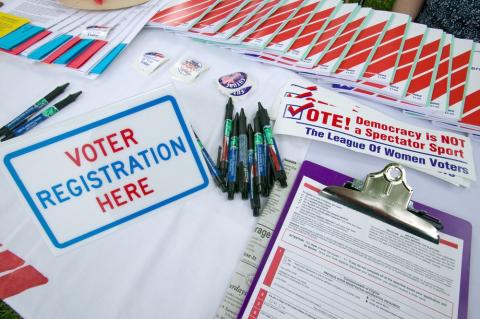Earlier this year, Utah and Washington quietly joined 14 other states that have eliminated the use of registration deadlines as a final cutoff to be able to vote. The congruent actions of a red state and blue state bring the number of states that allow voters to register or update a registration when they go to vote to nearly one in three.
It’s a critical threshold that could spell the end of voter registration deadlines as we’ve known them for 100 years.
Enabling voters to address and fix registration issues when they vote is hardly a new or untested idea. North Dakota eliminated their cutoff in 1951. Minnesota, Maine and Wisconsin followed in the 1970s. The change enabled a robust culture of voting that put them permanently at the top of high turnout states. New Hampshire, Iowa, Colorado, Illinois, California, and others followed.
The difference is striking. States with same-day or Election Day registration policies have outpaced the others in turnout for 20 years by 7 to 10 percentage points — even as the number of states with these policies has grown.
An advance deadline makes sense for registrations not submitted in person — those done by mail, online, through a public agency, or from a voter registration drive. But they have been long outdated as a final cutoff to register, as shown by the seven states that eliminated theirs more than 20 years ago.
Now technology, tracking, and improved election practices mean cutoffs for in-person registrations serve no purpose, unless it’s to limit voter participation or for candidates to narrow the number of voters they have to appeal to.
Today, voter registration cutoffs are arguably one of the largest legal forms of voter disenfranchisement. They needlessly prevent several million eligible voters from casting their ballots in every national election. In 2016, Colorado alone saw more than 200,000 voters that otherwise would have been turned away take advantage of their newly enacted same-day registration policy.
The remaining 34 states — including Pennsylvania, Florida, Ohio and Texas — are running out of excuses to keep advance cutoffs and maintain voter registration as a barrier to voting.
The National Conference of State Legislatures reports a state can expect up to a 7 percentage point increase in voter turnout after adoption of a same-day registration policy. Even half that increase in the 34 states that cut off registration weeks before the election would mean an additional two million people getting a chance to vote.
Who’s most likely to use same-day registration? It is generally younger voters, those new to the process, and voters less firmly tied to the two major parties. They’re also more likely to be undecided about whether to vote or who to vote for.
Undecided does not mean uninterested or less informed. These are voters ready to take the time to make the trip to their place of voting with every hope of claiming the right and responsibility of citizenship — to be a participant and have a voice.
Why deny these voters the opportunity to gain the benefits of being a voter? Voters are known to have a greater connection to their neighbors, improved health outcomes, and a higher likelihood of participating civically in other ways.
Other popular reforms can make a difference too: automatic voter registration; pre-registration of 16 and 17 year-olds; limiting voter purges. But in a country with more than 240 million eligible voters the largest problem will always be missed registration deadlines or fixable mistakes by voters, public agencies, or election offices.
Many states, like Nevada, Indiana, and Pennsylvania, are exploring enacting same-day registration policies and joining others that already have these policies in place.
In the meantime, Utah, Washington, and 14 others have set the bar and pushed the nation to end making voter registration a barrier — rather than a gateway — to active citizenship and voting.
Photo Credit: Joseph Sohm / shutterstock.com
